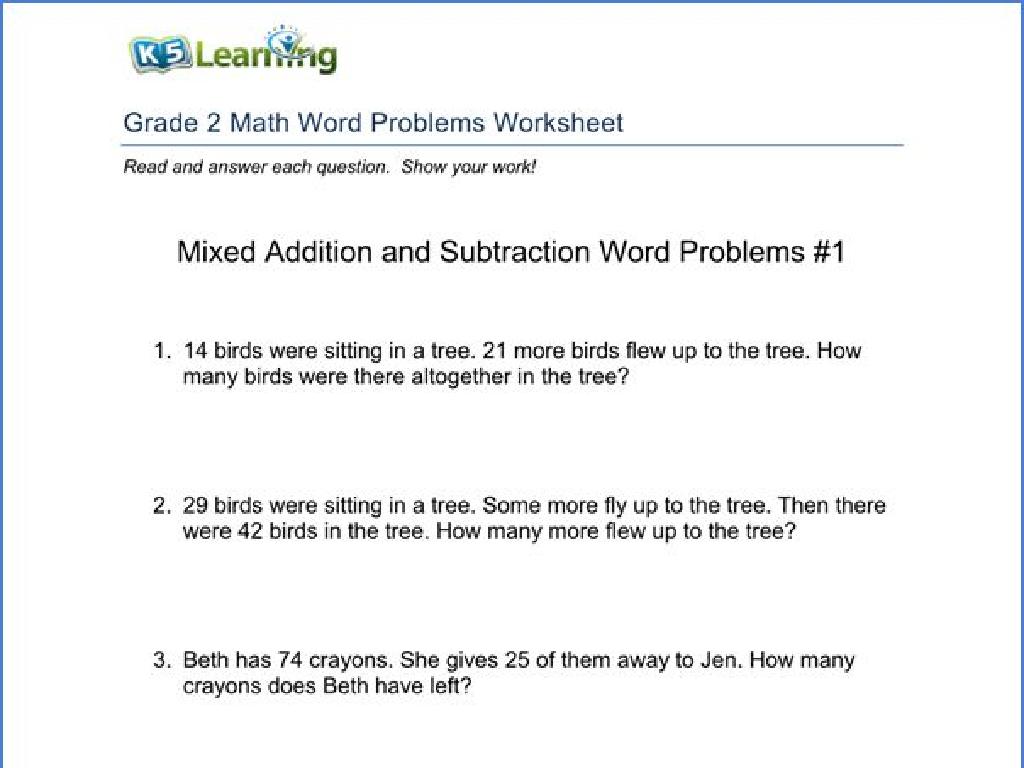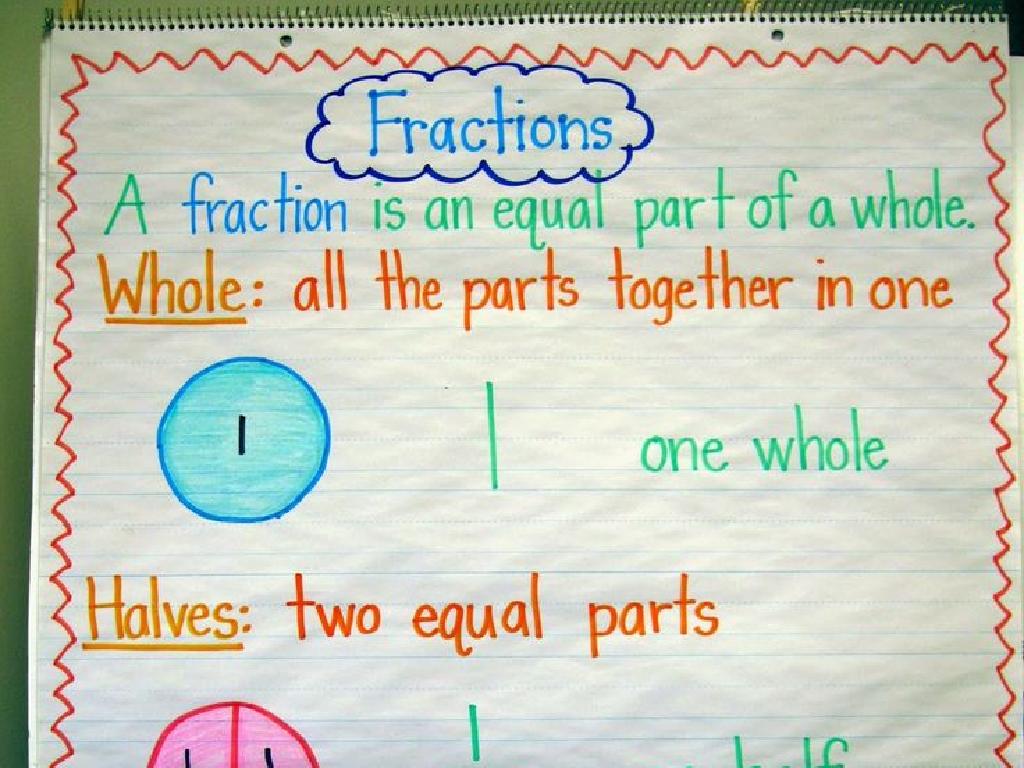Identify Nouns With Abstract Nouns
Subject: Language arts
Grade: Third grade
Topic: Nouns
Please LOG IN to download the presentation. Access is available to registered users only.
View More Content
Welcome to Nouns!
– Introduction to nouns
– Nouns are everywhere
– Nouns: Person, place, thing, idea
– Examples: teacher (person), school (place), book (thing), bravery (idea)
– Spot nouns in the classroom
– Let’s find nouns we can see right now!
|
Begin the class with a warm welcome and introduce the topic of nouns to the students. Explain that nouns are words that name people, places, things, and ideas. To make the concept more tangible, ask the students to look around the classroom and name objects they see, which will help them identify nouns as ‘things’. Then, extend the discussion to include ‘people’ and ‘places’ by using examples from the school or their homes. Finally, introduce the concept of abstract nouns by explaining that not all nouns can be touched or seen; some, like ‘bravery’, represent ideas or feelings. Encourage the students to think of other abstract nouns. This interactive approach will help students understand and identify different types of nouns in their environment.
Exploring Types of Nouns
– Four main types of nouns
– Common: dog, city; Proper: Fido, New York
– Examples: Common, Proper, Concrete, Abstract
– Concrete: apple; Abstract: bravery, happiness
– Today’s focus: Abstract Nouns
– Abstract Nouns represent ideas or concepts
– Love, courage, freedom are things you feel or think about
|
Begin the lesson by introducing the four main types of nouns to the students: common, proper, concrete, and abstract. Provide clear examples for each, ensuring that the students can distinguish between them. Common nouns are general names for things, while proper nouns name specific things and are capitalized. Concrete nouns are things you can touch, like ‘apple’, while abstract nouns represent ideas or feelings, like ‘bravery’ or ‘happiness’. Emphasize that the day’s lesson will focus on abstract nouns, which are not tangible but are very important in expressing complex ideas and emotions. Encourage students to think of more abstract nouns and how they are used in sentences to convey thoughts and feelings.
Exploring Abstract Nouns
– Abstract nouns definition
– Nouns not detectable by the five senses
– They represent intangible things
– Feelings, ideas, qualities, or concepts
– Examples: happiness, courage
– Happiness: feeling joy, Courage: being brave
– More examples: freedom, childhood
– Freedom: being free, Childhood: time of being a child
|
This slide introduces the concept of abstract nouns to third-grade students. Begin by explaining that abstract nouns are different from concrete nouns because they cannot be experienced with the senses. They are things we feel, think about, or understand, like emotions or ideas. Use examples that are relatable to the students, such as ‘happiness’ when they feel joy or ‘courage’ when they do something brave. Encourage the students to think of other abstract nouns and discuss how these words are important for expressing things we cannot touch or see but are very real in our lives.
Identifying Abstract Nouns
– What are abstract nouns?
– Abstract nouns are things you can t touch, like ‘happiness’ or ‘time’.
– Find abstract nouns in sentences
– Look at the sentence: ‘Bravery is admired.’ What can’t you touch?
– Discuss why they are abstract
– Because you can’t see or touch ‘bravery’, it’s an abstract noun.
– Practice with examples
|
This slide is aimed at helping third-grade students understand and identify abstract nouns. Begin by explaining that abstract nouns are things we can’t see, touch, or measure, like feelings or ideas. Show sentences with abstract nouns and guide students to recognize them by looking for things that can’t be experienced with the senses. Discuss the characteristics that make these nouns abstract, emphasizing that they represent intangible concepts. Provide practice sentences for students to apply their understanding, such as ‘Her kindness made her popular’ or ‘Justice is important in society.’ Encourage students to explain their reasoning for each example they identify.
Abstract vs. Concrete Nouns
– Chart: Abstract vs. Concrete
– Abstract nouns are feelings or ideas like ‘bravery’. Concrete nouns are things you can touch, like ‘apple’.
– Examples: Show differences
– ‘Happiness’ (abstract) vs. ‘dog’ (concrete)
– Student contributions
– Think of your own examples of abstract and concrete nouns to add to our chart.
– Understanding noun types
|
This slide is designed to help students differentiate between abstract and concrete nouns. Start with a clear chart that contrasts the two types of nouns. Abstract nouns represent things that cannot be seen, touched, or measured, like emotions or concepts. Concrete nouns are tangible and can be experienced with the senses. Provide clear examples for each and then engage the students by asking them to come up with their own examples. This activity will reinforce their understanding and help them apply the concept to real-life situations. Encourage them to think creatively and share their ideas in the next class.
Activity Time: Abstract Noun Hunt
– Find abstract nouns in books
– Work in small groups
– List your abstract nouns
– Nouns like bravery, joy, or friendship
– Discuss why you chose them
– Share reasons in your group
|
In this class activity, students will explore abstract nouns by searching for them in their favorite books or stories. Divide the class into small groups to foster collaboration. Each group will make a list of abstract nouns they find, such as ‘happiness,’ ‘anger,’ or ‘courage.’ After listing, encourage students to discuss within their groups why they chose each noun, focusing on the intangible qualities these words represent. This will help them understand the concept of abstract nouns as opposed to concrete nouns. As a teacher, circulate around the room, assist groups as needed, and prepare to facilitate a group discussion afterward where students can share their findings and reasoning with the class.
Share and Learn: Abstract Nouns
– Groups share their abstract nouns
– Discuss meanings of abstract nouns
– What feelings or ideas did you list?
– Questions to reinforce the concept
– Why do you think ‘happiness’ is abstract?
– Provide feedback on findings
|
This slide is designed for a collaborative classroom activity where students will engage with the concept of abstract nouns. After working in groups to identify abstract nouns, they will present their findings to the class. This sharing process will allow students to learn from each other and understand a wider range of abstract nouns. During the discussion, encourage students to explain the meanings of the nouns they found, which will help solidify their understanding. Ask probing questions to ensure comprehension and provide feedback to correct misunderstandings. This activity will reinforce the concept of abstract nouns, which are nouns that represent ideas, qualities, or feelings that cannot be seen or touched.
Wrapping Up: Abstract Nouns
– Recap on abstract nouns
– Abstract nouns are ideas, qualities, or states that you can’t touch.
– Homework: Craft a short story
– Write a story using words like ‘bravery’, ‘joy’, or ‘friendship’.
– Include five abstract nouns
– Find and use at least five abstract nouns in your story.
– Be creative with class nouns
– Use nouns we learned about like ‘happiness’, ‘wisdom’, or ‘growth’.
|
As we conclude, remind the students about the nature of abstract nouns: they represent things we cannot see or touch, like emotions or concepts. For homework, they should write a short story that includes at least five abstract nouns, which will help reinforce their understanding of the concept. Encourage them to be imaginative and to draw upon nouns discussed during the lesson. This activity will not only assess their grasp of abstract nouns but also foster creativity and application of the lesson in a fun, engaging way. Provide examples of abstract nouns to spark ideas and offer support for students who may need help getting started.





